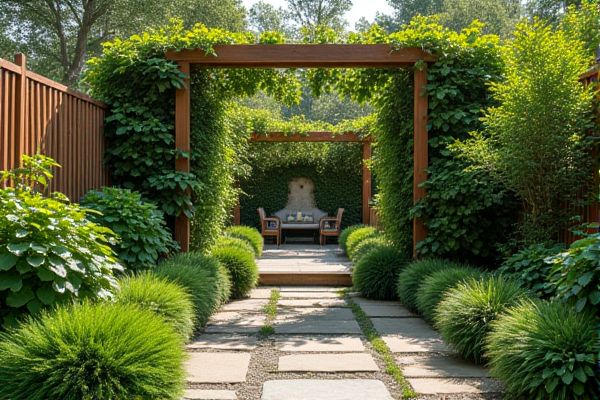
A climbing plant trellis provides vertical support for plants to grow and can enhance garden aesthetics, while a privacy screen serves primarily to block views and create secluded outdoor spaces. Discover how each option can transform Your garden and which one best suits Your needs in the full article.
Table of Comparison
| Feature | Climbing Plant Trellis | Privacy Screen |
|---|---|---|
| Primary Purpose | Support for climbing plants | Provide visual privacy and block views |
| Material | Wood, metal, bamboo | Wood, vinyl, metal, fabric |
| Installation | Wall-mounted or freestanding | Freestanding panels or anchored posts |
| Design | Open lattice for plant growth | Solid or semi-solid panels |
| Height | Typically 6-8 feet | Typically 4-8 feet |
| Maintenance | Plant care and occasional cleaning | Cleaning and occasional repairs |
| Privacy Level | Partial; depends on plant coverage | High; blocks direct views |
| Environmental Benefits | Supports greenery and biodiversity | Limited, primarily functional |
| Cost | Low to moderate; depends on material and plants | Moderate to high; depends on material and size |
| Best Use | Gardens, patios for growing vines | Backyards, balconies for privacy |
Introduction: Climbing Plant Trellis vs Privacy Screen
Climbing plant trellises are structures designed to support vines and ornamental plants, enhancing vertical garden aesthetics while promoting healthy growth. Privacy screens offer a functional solution to block external views and create secluded outdoor spaces, often combining materials such as wood, metal, or composite panels for durability and design versatility. Both trellises and privacy screens can be integrated with climbing plants, but trellises primarily focus on plant support, whereas privacy screens emphasize visual obstruction and privacy enhancement.
Purpose and Functionality Comparison
A climbing plant trellis primarily serves as a support structure for vines and climbing plants, promoting vertical growth and enhancing garden aesthetics. Privacy screens are designed to create visual barriers, offering seclusion by blocking views and reducing noise, often incorporating plants or solid materials. Your choice depends on whether you prioritize plant growth support or maximizing privacy in your outdoor space.
Material Options for Trellises and Privacy Screens
Trellises commonly feature materials like wood, metal, and vinyl, offering durability and aesthetic appeal for supporting climbing plants. Privacy screens, on the other hand, often utilize bamboo, lattice panels, or synthetic composites designed to block visibility while providing weather resistance. Selecting materials depends on factors such as longevity, maintenance requirements, and desired level of privacy or plant support.
Aesthetic Impact on Garden Design
Climbing plant trellises create a vertical focal point that enhances garden aesthetics by adding texture and natural beauty through flowering vines or lush foliage. Privacy screens offer a more substantial visual barrier, often designed with materials or dense plantings that contribute structure and seclusion, impacting the garden's overall sense of intimacy. Both elements can transform outdoor spaces, but trellises emphasize elegance and openness while privacy screens prioritize enclosure and bold design statements.
Plant Compatibility and Growth Support
Climbing plant trellises are ideal for plants like clematis, ivy, and climbing roses that require vertical structures to grow upwards, providing strong support for vines and tendrils. Privacy screens, often constructed from wood or metal panels, can support plants such as bamboo or tall grasses, which thrive in denser, more sheltered environments. Both structures enhance plant growth by offering stability and promoting healthy airflow, but trellises are better suited for delicate climbers while privacy screens accommodate bulkier, bushier species.
Installation and Maintenance Requirements
Climbing plant trellises generally require minimal installation, often involving simple anchoring to a wall or support structure, and demand regular pruning to maintain plant health and aesthetic appeal. Privacy screens, while sometimes more complex to install due to size and material weight, offer immediate visual blockage but may require occasional cleaning and treatment to prevent weather-related damage. Both options benefit from routine inspections to ensure structural integrity and optimal performance in garden or outdoor living spaces.
Durability and Longevity Considerations
Climbing plant trellises are typically made from wood, metal, or vinyl, with metal and vinyl offering greater durability and resistance to weathering compared to wood, which may require regular maintenance to prevent rot and decay. Privacy screens, often crafted from composite materials or treated wood, are designed for long-term use and can withstand harsh outdoor conditions while maintaining structural integrity and appearance. When selecting a structure for your garden, consider the material quality and exposure to elements to ensure your investment in durability and longevity meets your outdoor privacy or decorative needs.
Privacy Level and Coverage Effectiveness
A climbing plant trellis provides moderate privacy by supporting vertical growth, allowing foliage to create natural coverage while still letting light and air pass through. Privacy screens offer higher coverage effectiveness with denser materials designed specifically to block views and enhance seclusion in your outdoor space. Choosing between them depends on whether you prioritize natural aesthetics with some transparency or maximum privacy with solid screening.
Cost Analysis: Upfront and Long-term Expenses
Climbing plant trellises typically involve lower upfront costs due to simpler materials like wood or metal, while privacy screens often require more investment for durable, weather-resistant construction. Over time, maintenance expenses for trellises may increase as plants grow and need pruning, whereas privacy screens can incur costs for cleaning or replacement depending on the material's lifespan. Your choice should consider both initial budget and potential long-term financial commitments for upkeep and durability.
Choosing the Best Solution for Your Outdoor Space
A climbing plant trellis offers a natural, aesthetic appeal by supporting vertical growth of vines and flowers, enhancing garden beauty without obstructing views. Privacy screens provide immediate blockage from neighbors or street views, often using materials like wood, metal, or synthetic panels for durability and full coverage. Selecting the best solution depends on your outdoor space's privacy needs, desired maintenance level, and visual impact.
 homyna.com
homyna.com